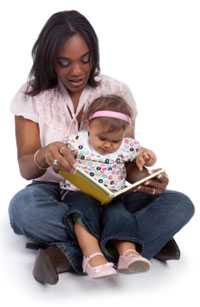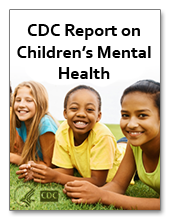Toddlers (1-2 years of age)

Developmental Milestones
Skills such as taking a first step, smiling for the first time, and waving “bye-bye” are called developmental milestones. Developmental milestones are things most children can do by a certain age. Children reach milestones in how they play, learn, speak, behave, and move (like crawling, walking, or jumping).
During the second year, toddlers are moving around more, and are aware of themselves and their surroundings. Their desire to explore new objects and people also is increasing. During this stage, toddlers will show greater independence; begin to show defiant behavior; recognize themselves in pictures or a mirror; and imitate the behavior of others, especially adults and older children. Toddlers also should be able to recognize the names of familiar people and objects, form simple phrases and sentences, and follow simple instructions and directions.
Positive Parenting Tips
Following are some of the things you, as a parent, can do to help your toddler during this time:

- Read to your toddler daily.
- Ask her to find objects for you or name body parts and objects.
- Play matching games with your toddler, like shape sorting and simple puzzles.
- Encourage him to explore and try new things.
- Help to develop your toddler’s language by talking with her and adding to words she starts. For example, if your toddler says “baba”, you can respond, “Yes, you are right―that is a bottle.”
- Encourage your child’s growing independence by letting him help with dressing himself and feeding himself.
- Respond to wanted behaviors more than you punish unwanted behaviors (use only very brief time outs). Always tell or show your child what she should do instead.
- Encourage your toddler’s curiosity and ability to recognize common objects by taking field trips together to the park or going on a bus ride.
Child Safety First
Because your child is moving around more, he will come across more dangers as well. Dangerous situations can happen quickly, so keep a close eye on your child. Here are a few tips to help keep your growing toddler safe:
- Do NOT leave your toddler near or around water (for example, bathtubs, pools, ponds, lakes, whirlpools, or the ocean) without someone watching her. Fence off backyard pools. Drowning is the leading cause of injury and death among this age group.
- Block off stairs with a small gate or fence. Lock doors to dangerous places such as the garage or basement.
- Ensure that your home is toddler proof by placing plug covers on all unused electrical outlets.
- Keep kitchen appliances, irons, and heaters out of reach of your toddler. Turn pot handles toward the back of the stove.
- Keep sharp objects such as scissors, knives, and pens in a safe place.
- Lock up medicines, household cleaners, and poisons.
- Do NOT leave your toddler alone in any vehicle (that means a car, truck, or van) even for a few moments.
- Store any guns in a safe place out of his reach.
- Keep your child’s car seat rear-facing as long as possible. According to the National Highway Traffic Safety Administration it’s the best way to keep her safe. Your child should remain in a rear-facing car seat until she reaches the top height or weight limit allowed by the car seat’s manufacturer. Once your child outgrows the rear-facing car seat, she is ready to travel in a forward-facing car seat with a harness.
Positive Parenting Tip Sheet
Healthy Bodies
- Give your child water and plain milk instead of sugary drinks. After the first year, when your nursing toddler is eating more and different solid foods, breast milk is still an ideal addition to his diet.
- Your toddler might become a very picky and erratic eater. Toddlers need less food because they don’t grow as fast. It’s best not to battle with him over this. Offer a selection of healthy foods and let him choose what she wants. Keep trying new foods; it might take time for him to learn to like them.
- Limit screen time. For children younger than 2 years of age, the AAP recommends that it’s best if toddlers not watch any screen media.
- Your toddler will seem to be moving continually—running, kicking, climbing, or jumping. Let him be active—he’s developing his coordination and becoming strong.
For More Information
CDC’s “Learn the Signs. Act Early.” Campaign
For more details on developmental milestones, warning signs of possible developmental delays, and information on how to help your child’s development, visit the “Learn the Signs. Act Early.” campaign website.
CDC’s Parent Information (Children 0―3 years)
This site has information to help you learn how to give your child a healthy start in life.
CDC’s Essentials for Parenting Toddlers and Preschoolers
Learn ways you can help build a safe, stable, and nurturing relationship with your child.
CDC’s Breastfeeding Information.
This site has answers to frequently asked questions about breastfeeding.
CDC’s Healthy Weight Information.
Tips for Parents – Ideas to help children maintain a healthy weight.
CDC’s Protect the Ones You Love
CDC’s Injury Center has information on how you can protect your child from drowning and other common causes of injury.
Bright Futures
Bright Futures provides information on what to expect as your baby grows, including parenting tips. Patient/parent education handouts are available for your child’s regular check-up visit with your healthcare provider from 2-5 days of age until 18-21 years of age.
Choose My Plate- Preschoolers
The U.S. Department of Agriculture provides information on health and nutrition for 2 through 5 years of age.
HealthyChildren.org
AAP’s Healthy Children website provides information on feeding, nutrition, and fitness for all developmental stages from infancy to young adulthood.
Just in Time Parenting (JITP)
Quality, research-based information to families at the time it can be most useful.
Let’s Move – Child Care
You will find information on physical activity for young children and on ways to keep them moving.
National Highway Traffic Safety Administration (NHTSA)
NHTSA has information on safety recalls and safety tips for children riding in motor vehicles, walking, biking, playing outside, waiting at school bus stops, and more.
National Institute of Child Health and Human Development. (NICHD)
Visit NICHD to learn how to reduce the risk of Sudden Infant Death Syndrome (SIDS) and about safe sleep environments.
Vaccines
View the child immunization schedule and find out if your child’s vaccinations are up to date.
World Health Organization information on infant nutrition
This site has information to promote proper feeding for infants and young children.
CDC’s “Learn the Signs. Act Early.” Campaign
For more details on developmental milestones, warning signs of possible developmental delays, and information on how to help your child’s development, visit the “Learn the Signs. Act Early.” campaign website.
CDC’s Parent Information (Children 4−11 years)
This site has information to help you guide your child in leading a healthier life.
CDC’s Essentials for Parenting Toddlers and Preschoolers
Learn ways you can help build a safe, stable, and nurturing relationship with your child.
CDC’s Healthy Weight Information.
Tips for parents – Ideas to help children maintain a healthy weight.
Bright Futures
Bright Futures provides information on what to expect as your baby grows, including parenting tips. Patient/parent education handouts are available for your child’s regular check-up visit with your healthcare provider from 2-5 days of age until 18-21 years of age.
Building Blocks
SAMHSA’s Building Blocks help parents, caregivers, and educators of children ages 3 to 6 in creating safe, supportive, and nurturing environments for young children to help them grow up mentally healthy and drug-free.
Choose My Plate- Preschoolers
The U.S. Department of Agriculture provides information on health and nutrition for children 2 through 5 years of age.
HealthyChildren.org
AAP’s Healthy Children website provides information on feeding, nutrition, and fitness for all developmental stages from infancy to young adulthood.
Just in Time Parenting (JITP)
Quality, research-based information to families at the time it can be most useful.
Let’s Move – Child Care
You will find information on physical activity for young children and on ways to keep them moving.
National Highway Traffic Safety Administration (NHTSA)
NHTSA has information on safety recalls and safety tips for children riding in motor vehicles, walking, biking, playing outside, waiting at school bus stops, and more.
CDC’s Parent Information (Children 4 — 11 years)
This site has information to help you guide your child in leading a healthier life.
CDC’s Healthy Weight Information.
Tips for parents – Ideas to help children maintain a healthy weight.
CDC’s Youth Physical Activity Guidelines Toolkit
This site has information on how to help children be active and play.
KidsQuest
KidsQuest is a CDC website designed for students in fourth, fifth, and sixth grades, to get them to think about people with disabilities and some of the issues related to daily activities, health, and accessibility.
BAM! Body and Mind
CDC’s BAM! Body and Mind is a website designed for kids 9 through 13 years of age to give them the information they need to make healthy lifestyle choices. The site focuses on topics that kids told us are important to them—such as stress and physical fitness—using kid-friendly lingo, games, quizzes, and other interactive features.
Bright Futures
Bright Futures provides information on what to expect as your baby grows, including parenting tips. Patient/parent education handouts are available for your child’s regular check-up visit with your healthcare provider from 2-5 days of age until 18-21 years of age.
Choose My Plate – Children over 5.
The U.S. Department of Agriculture provides information on health and nutrition for children over 5 years of age.
HealthyChildren.org
AAP’s Healthy Children website provides information on feeding, nutrition, and fitness for all developmental stages from infancy to young adulthood. Visit this website to learn more about emotional problems, learning disabilities and other health and development concerns.
Just in Time Parenting (JITP)
Quality, research-based information to families at the time it can be most useful.
Let’s Move-Parents
Five simple steps for parents towards creating a healthy environment at home.
National Highway Traffic Safety Administration (NHTSA)
NHTSA has information on safety recalls and safety tips for children riding in motor vehicles, walking, biking, playing outside, waiting at school bus stops, and more.
StopBullying.gov
StopBullying.gov provides information from various government agencies on how kids, teens, young adults, parents, educators and others in the community can prevent or stop bullying.
SAMHSA’s KnowBullying app
A free app for parents to help prevent bullying, created by the Substance Abuse and Mental Health Agency (SAMHSA).
Teens Health
Visit this site for information on healthy eating and exercise for children and teenagers, safety tips for your child at home when you can’t be there, and other important health and safety topics.
CDC’s Parent Information (Teens 12— 19)
This site has information to help you learn how to guide your teen to be safe and become a healthy and productive adult.
CDC’s Healthy Weight Information.
Tips for parents – Ideas to help children maintain a healthy weight.
CDC’s Pregnancy Prevention for Teens.
Tips and information especially for teens and designed with input from teens.
American Academy of Child & Adolescent Psychiatry
The American Academy of Child & Adolescent Psychiatry has many fact sheets for parents on child and adolescent health and development.
BAM! Body and Mind
CDC’s BAM! Body and Mind is a website designed for kids 9 through13 years of age, to give them the information they need to make healthy lifestyle choices. The site focuses on topics that kids told us are important to them—such as stress and physical fitness—using kid-friendly lingo, games, quizzes, and other interactive features.
Bright Futures
Bright Futures provides information on what to expect as your baby grows, including parenting tips. Patient/parent education handouts are available for your child’s regular check-up visit with your healthcare provider from 2-5 days of age until 18-21 years of age.
Choose My Plate
The U.S. Department of Agriculture provides information on health and nutrition.
HealthyChildren.org
AAP’s Healthy Children website provides information on feeding, nutrition, and fitness for all developmental stages from infancy to young adulthood.
Just in Time Parenting (JITP)
Quality, research-based information to families at the time it can be most useful.
Let’s Move-Kids
Five simple steps for kids towards growing up healthy.
National Highway Traffic Safety Administration (NHTSA)
NHTSA has information on safety recalls and safety tips for children riding in motor vehicles, walking, biking, playing outside, waiting at school bus stops, and more.
National Institute of Mental Health
The National Institute of Mental Health has information on mental disorders affecting children and adolescents, including anxiety and depression.
StopBullying.gov
StopBullying.gov provides information from various government agencies on how kids, teens, young adults, parents, educators, and others in the community can prevent or stop bullying.
SAMHSA’s KnowBullying app
A free app for parents to help prevent bullying, created by the Substance Abuse and Mental Health Agency (SAMHSA).
Substance Abuse and Mental Health Services Administration (SAMHSA)
SAMHSA works to improve the quality and availability of substance abuse prevention, alcohol and drug addiction treatment, and mental health services.
Teens Health
Visit this site for information on healthy eating and exercise for children and teenagers.
- Page last reviewed: February 1, 2017
- Page last updated: January 3, 2017
- Content source:
- Division of Human Development and Disabilities, National Center on Birth Defects and Developmental Disabilities, Centers for Disease Control and Prevention



 ShareCompartir
ShareCompartir